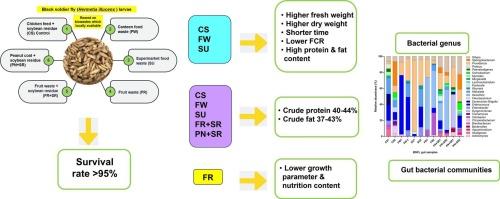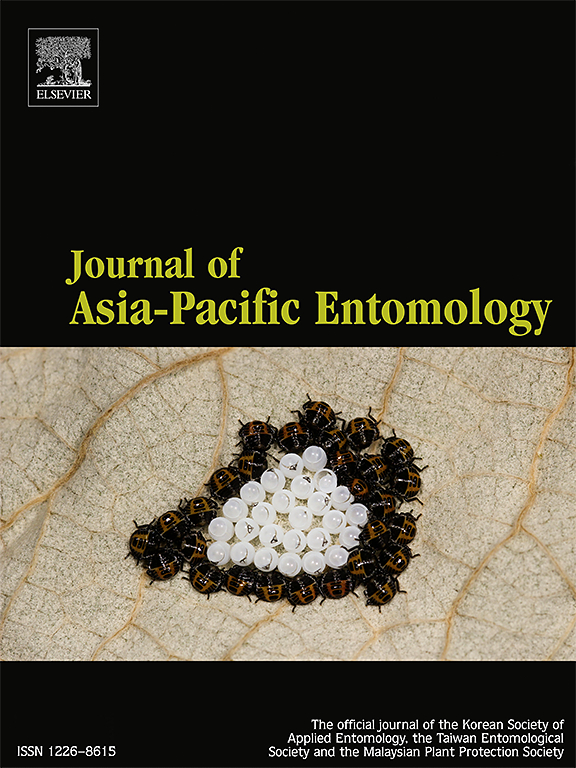生物废弃物饲养黑虻幼虫生长性能及肠道菌群评价
IF 1.3
3区 农林科学
Q3 ENTOMOLOGY
引用次数: 0
摘要
黑兵蝇幼虫(BSFL; Hermetia illucens)将低价值的残留物分解成高质量的营养生物质。利用当地可利用的有机废物,并考虑饲料应用中的生物安全问题,研究了不同废物基质(食物垃圾(FW)、超市食品残渣(SU)、水果垃圾(FR)、水果垃圾与豆渣混合(FR + SR)和花生皮与豆渣混合(PN + SR))对BSFL生长性能、体组成和肠道细菌群落的影响,并与对照标准基质(CS)进行了比较。所有底物的存活率均为95%;然而,生长参数各不相同。FW的幼虫生物量高于其他基质,其营养价值与CS相似。这些底物影响肠道细菌的多样性和组成。高通量扩增子测序结果显示,FR + SR、CS和PN + SR喂养的幼虫肠道多样性指数较高。变形菌门、厚壁菌门和拟杆菌门被确定为丰富的门。丰富的属包括核心肠道微生物群落的典型成员,如普罗维登菌、肠球菌和克雷伯菌,它们的存在和相对丰度在不同的摄食底物类型中存在差异。这些发现为支持在BSFL饲养中使用当地可获得的有机残留物提供了有价值的信息。此外,对细菌多样性的深入了解将有助于建立使用BSFL作为食品和饲料的安全措施。本文章由计算机程序翻译,如有差异,请以英文原文为准。

Assessment of growth performance and gut bacterial communities of black soldier fly larvae reared on biowaste
Black soldier fly larvae (BSFL; Hermetia illucens) decompose low-value residues into high-quality nutrient biomass. Using organic waste that was locally available and taking into account biosafety concerns in feed application, we investigated the growth performance, body composition, and gut bacterial communities of BSFL fed with different waste substrates including food waste (FW), supermarket food leftovers (SU), fruit waste (FR), fruit waste mixed with soybean residue (FR + SR), and peanut coat mixed with soybean residue (PN + SR) compared with control standard substrate (CS). All substrates showed a survival rate > 95 %; however, growth parameters varied. FW resulted in higher larval biomass yields than the other substrates, producing nutritional value similar to that of CS. These substrates affect bacterial gut diversity and composition. High-throughput amplicon sequencing revealed that larval guts fed FR + SR, CS, and PN + SR had higher diversity indices. Proteobacteria, Firmicutes, and Bacteroidota were identified as abundant phyla. Abundant genera included typical members of the core gut microbial community, such as Providencia, Enterococcus, and Klebsiella, with differences in their presence and relative abundances among feeding substrate types. These findings provide valuable information supporting the use of locally available organic residues in BSFL feeding. Additionally, the insights gained into bacterial diversity will contribute to establishing safety measures for the use of BSFL as food and feed.
求助全文
通过发布文献求助,成功后即可免费获取论文全文。
去求助
来源期刊

Journal of Asia-pacific Entomology
Agricultural and Biological Sciences-Insect Science
CiteScore
2.70
自引率
6.70%
发文量
152
审稿时长
69 days
期刊介绍:
The journal publishes original research papers, review articles and short communications in the basic and applied area concerning insects, mites or other arthropods and nematodes of economic importance in agriculture, forestry, industry, human and animal health, and natural resource and environment management, and is the official journal of the Korean Society of Applied Entomology and the Taiwan Entomological Society.
 求助内容:
求助内容: 应助结果提醒方式:
应助结果提醒方式:


